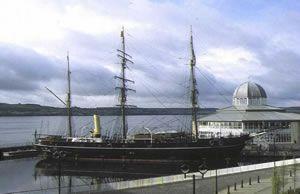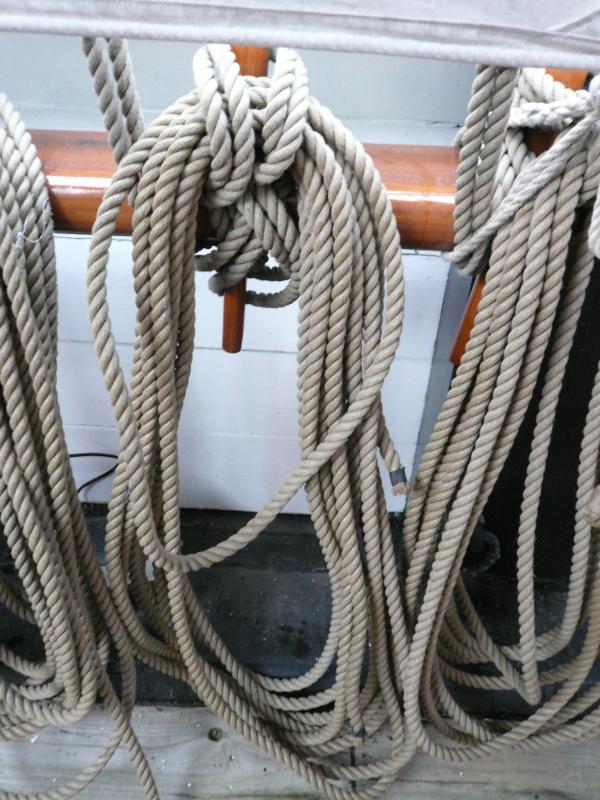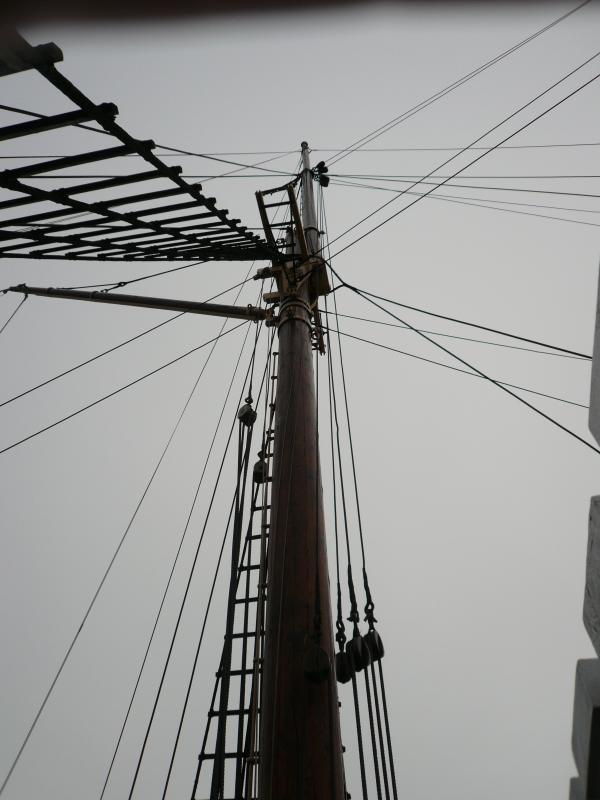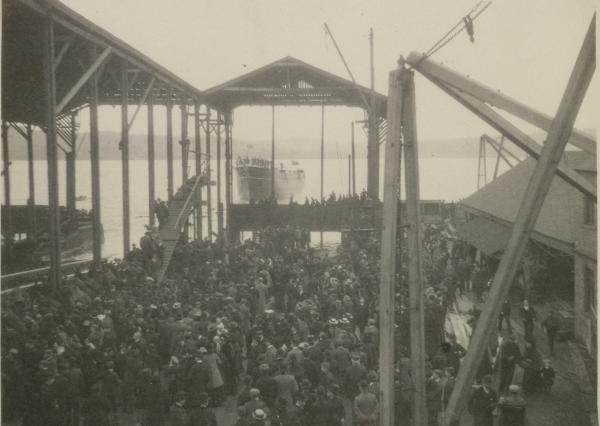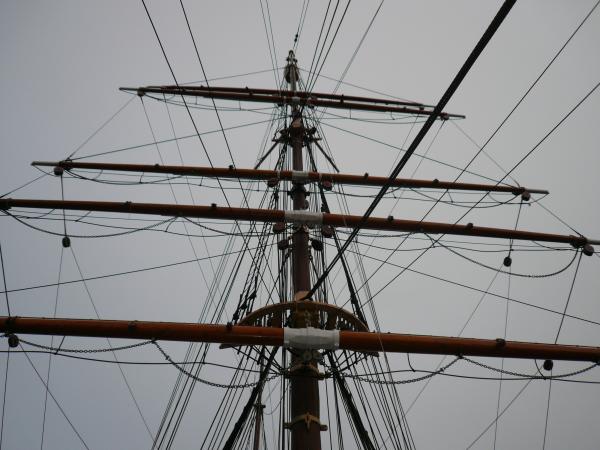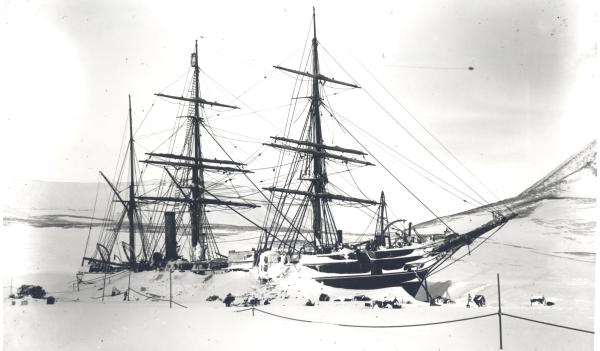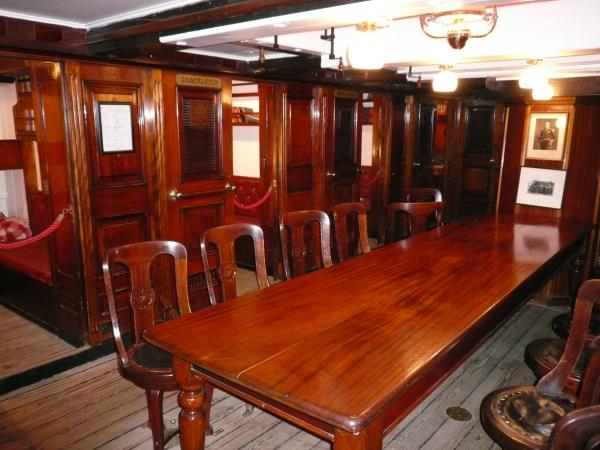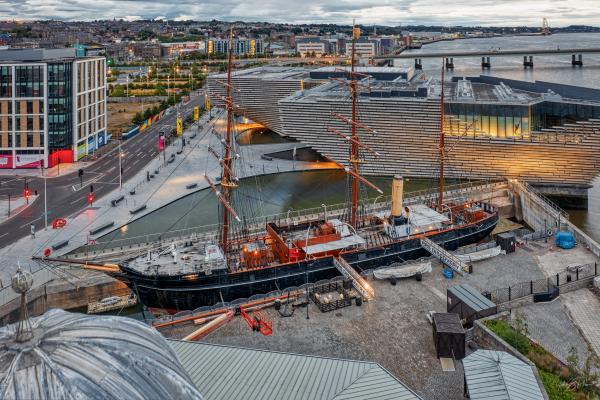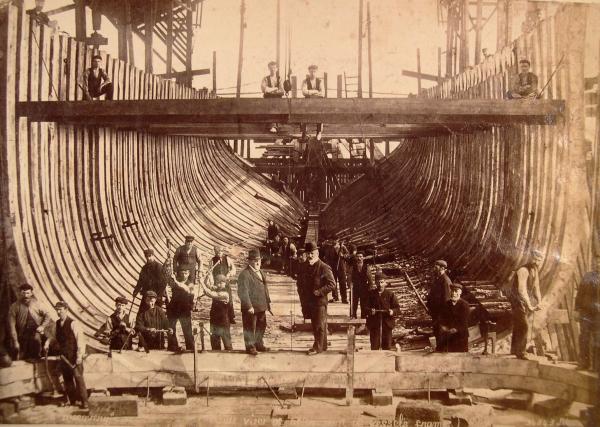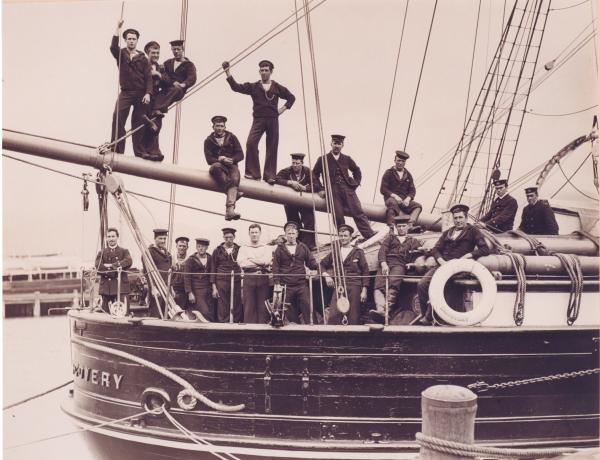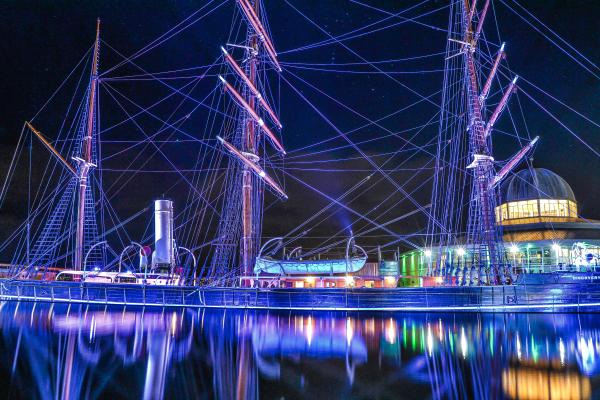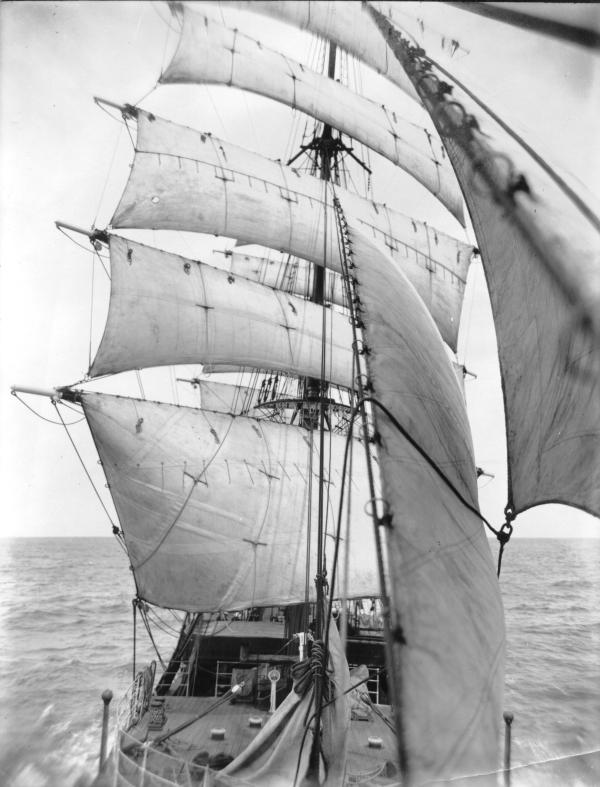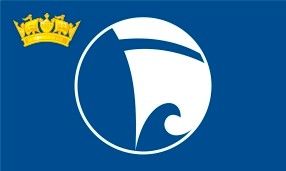
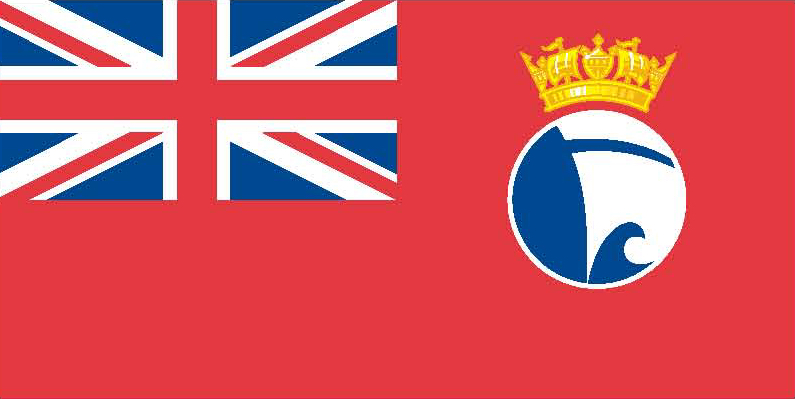
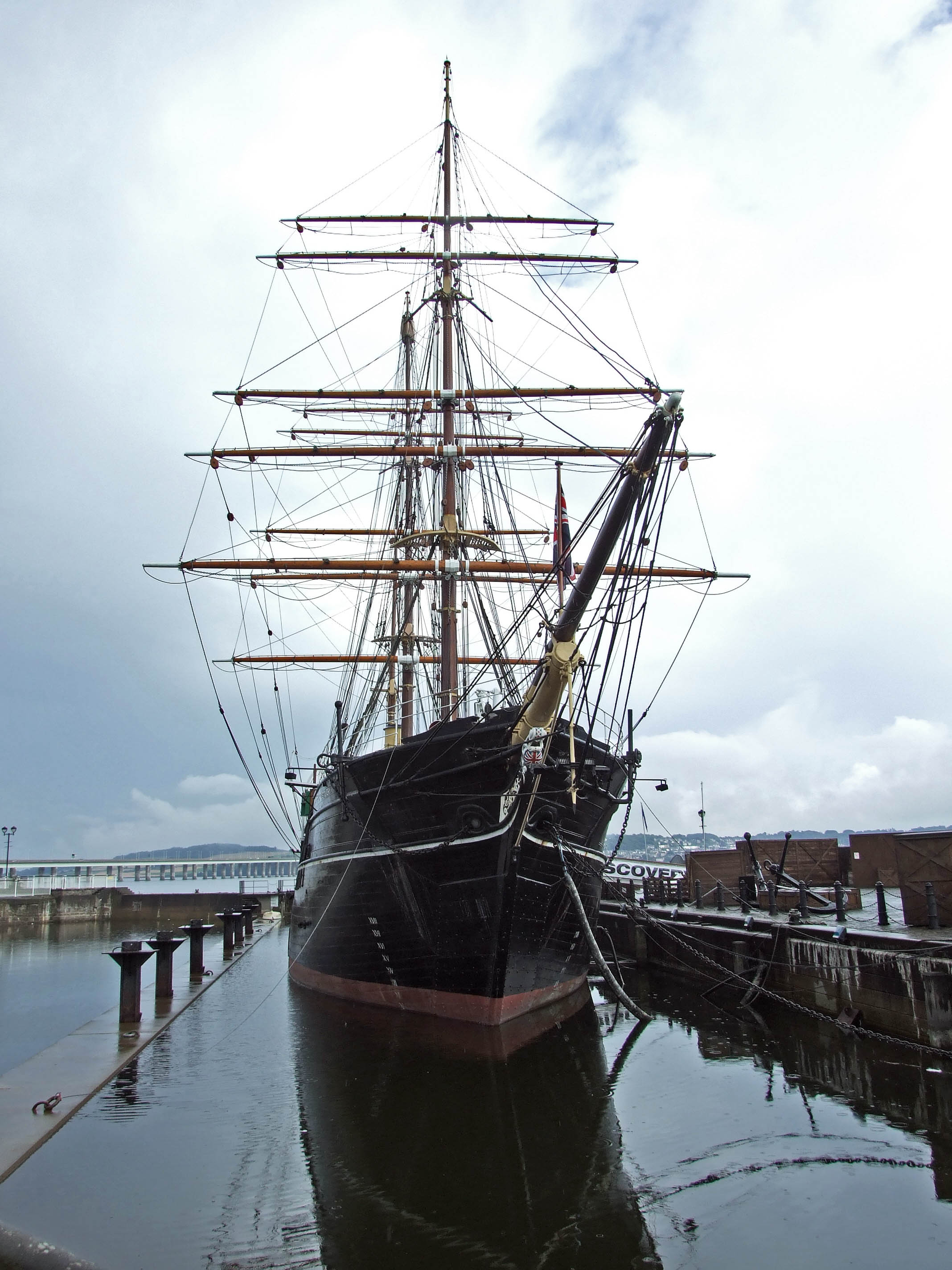
Details
Construction
Dimensions
History
DISCOVERY was built for the National Antarctic Expedition 1901-4 and is one of the last three-masted wooden ships built in this country. She was designed by Sir William Smith with a full hull form and tumblehome and was unique, having a lifting propeller and rudder, but able to be steered and steamed if she lost her Rudder Post. In 1905, she was sold to the Hudson Bay Company who gutted all the accommodation below the Upper Deck, used the laboratories on the Upper Deck for the Officers accommodation with a saloon between them, and a bridge over them, moved the capstan onto the fo’c’sle head, and put the crew in the foc’s’le. In this form she carried supplies to the Trading Post in the Hudson Bay, and brought furs back.
DISCOVERY was the first vessel to be constructed specifically for scientific research. She was built in Dundee for the 1901 British National Antarctic Expedition, led by Captain Robert Falcon Scott. Dundee was then a major whaling centre, and its shipyards had long experience of constructing ships robust enough to travel through pack ice.
Following her return to England from the Antarctic in late 1904 she was sold to the Hudson’s Bay Company to carry supplies to the trading posts in the Hudson Bay, and to bring furs back. After the start of the First World War she was used to transport munitions and food between North America and France.
Ernest Shackleton had been third officer on Scott’s 1901-04 DISCOVERY Expedition. This was his first experience of the polar regions, but he was sent home early on health grounds. He determined to make amends for this perceived personal failure, and returned to Antarctica in 1907 as leader of the NIMROD expedition. He later planned further expeditions; he spent several years planning his Imperial Trans-Antarctic (ocean-to-ocean) expedition, and was finally ready to leave in early Summer 1914. His ship ENDURANCE was brand new, and was delivered to London in June 1914. On 1 August 1914 she set sail, initially for Plymouth.
With the declaration of war on 4 August Shackleton called his men together. He stated that they were free to join the war effort, and then placed his ship, ENDURANCE, her stores and her staff at the disposal of the Admiralty. The Admiralty declined the offer, as did most of the crew. On 8 August 1914, ENDURANCE sailed from Plymouth for Buenos Aires, docking there in early October 1914. She left for Antarctica on 26 October 1914.
The subsequent destruction of ENDURANCE meant the expedition had to be abandoned and plans made to be rescued. Shackleton later undertook an epic voyage with two of his men in the JAMES CAIRD lifeboat from Elephant Island to South Georgia, a distance of 800 nautical miles leaving the rest of his crew to endure 4 months of hardship on Elephant Island. The JAMES CAIRD was launched on 24 April 1916 and reached South Georgia on 10 May 1916. Shackleton reached the whaling station Husvik on 20 May 1916. This triggered the rescue effort in which DISCOVERY was to play a part.
Several attempts to rescue the remaining men on Elephant Island were made but failed. Shackleton, Worsley and Crean left on the British whaler SOUTHERN SKY, which had been laid up for the winter bound for Elephant Island on 23 May. She could not get through because of ice, and had to return to Port Stanley. A second attempt was made in late May in a Uruguayan survey ship, the INSTITUTO DE PESCA. She too failed to get through, and had to return to Port Stanley.
The predicament of Shackleton and his crew received widespread media and particularly newspaper attention in Britain. His arrival at the whaling station was received with great excitement; photographs were published in the Daily Mirror on 10 July 1916. The Times reported on 24 July 1916 that ‘in view of the possibility of the failure of the third attempt now being carried out by Sir Ernest Shackleton in a small vessel, to rescue the 22 men of his party left on Elephant Island, South Shetlands, and at his most urgent request, the Government have now decided to despatch a vessel from England as soon as she can be fitted out, no suitable wooden vessel being available in any South American port.’
DISCOVERY’s send-off to bring back Shackleton and his crew was arranged with extensive publicity. An Admiralty Order instructed that ‘ships are to cheer when DISCOVERY passes down harbour today’. A memorandum was sent from the Commander-in-Chief Devonport to the Commanding Officer of HMS DISCOVERY ‘showing the arrangements which have been made for taking photographs and filming the voyage of the DISCOVERY’. The filmed rescue of Shackleton would hopefully be a good news story and a welcome diversion.
Discovery was accompanied by the collier POLESLEY, which initially towed her. Her captain was instructed to ‘keep a good look out for and avoid any suspicious vessels which may endeavour to close you’. His Orders (‘to be destroyed by fire on arrival at destination’) included a note that he would ‘be escorted by two Patrol vessels for a certain distance after leaving this port’.
On 11 August 1916 The Times reported that ‘the Antarctic relief ship DISCOVERY, which has been fitted out at Devonport dockyard for a fourth attempt to relieve the 22 men of Sir E. Shackleton’s party stranded on Elephant Island, left Plymouth Sound last night. She will proceed to Port Stanley, Falkland Islands, to embark Sir E. Shackleton.’
Shackleton himself referred to the departure of DISCOVERY in his account of the expedition, South:
We reached Port Stanley in the schooner [EMMA] on August 8 [1916], and I learned there that the ship DISCOVERY was to leave England at once and would be at the Falklands Islands about the middle of September. My good friend the Governor said I could settle down at Port Stanley and take things quietly for a few weeks. The street of that port is about a mile and a half long. It has the slaughterhouse at one end and the graveyard at the other. The chief distraction is to walk from the slaughterhouse to the graveyard. For a change one may walk from the graveyard to the slaughterhouse.
I could not content myself to wait for six or seven weeks, knowing that six hundred miles away my comrades were in dire need. I asked the Chilean Government to send the Yelcho, the steamer that had towed us before, to take the schooner across to Punta Arenas, and they consented promptly, as they had done to every other request of mine. So in a north-west gale we went across, narrowly escaping disaster on the way, and reached Punta Arenas on August 14 [1916].
On 22 August 1916 DISCOVERY arrived at Point do Sol, Cape Verde, and on 11 September 1916 at Montevideo, Uruguay. It was here that the Captain, Lieutenant-Commander J. Fairweather RNVR, of Dundee, learned that Shackleton had already been rescued. The Chilean Government had eventually offered the use of YELCHO, a small steamer. This successfully reached Elephant Island at lunchtime on 30 August 1916. YELCHO subsequently arrived at Punta Arenas in Chile on 3 September with all the crew on board. On 15 September she departed from Punta Arenas for Valparaiso, Chile.
Thus DISCOVERY was not needed, and waited at Montevideo for further instructions. On 17 September 1916 she set sail initially for Buenos Aires, Argentina, leaving there bound for home on 30 September, after calling in at several ports en route. These included stops at Pernambuco, Brazil, on 16 October, and at St Vincent in the Caribbean on 8 November. She left St Vincent bound finally for Devonport, UK on 15 November 1916, arriving at Devonport on 29 November 1916. The last page of the log book records; ‘voyage completed. All crew finished with ship’. She was decommissioned.
Shackleton himself was anxious not to return to the UK before rescuing the members of his expedition who had set out from New Zealand to provide supplies and support to the team on their arrival at the Ross Sea. On 8 October 1916 Shackleton and Worsley left Buenos Aires by train for New Orleans, where they again set off by train for San Francisco. Here they caught a steamer, the SS MOANA, to Wellington, New Zealand. From there they caught up with arrangements for the rescue of the Ross Sea team.
After decommissioning DISCOVERY was returned to the Hudson Bay Company, and for the remainder of the war she continued with her duties carrying food and munitions between North America and France. After the war DISCOVERY returned to the Antarctic region two more times as part of the Oceanographic Expedition 1925-1927 and BANZARE 1929-1931.
In 1929, she was lent to Sir Douglas Mawson for his two British, Australian, and New Zealand Antarctic Research Expeditions. In this expedition almost a third of the Antarctic coastline was charted for the first time, and many places were named, including Proclamation Island, after members and sponsors of the expedition. Afterwards DISCOVERY was laid up in the West India Docks until she was presented to the Boy Scout Association, and endowed by Lady Houston. She became a memorial to Antarctic heroes, the Headquarters for Sea Scouts, a centre for their training, and an accommodation ship for Scouts or Sea Scouts visiting London. She was berthed on a pier by Temple Tube Station, funded by the Pilgrim Trust. During World War Two, DISCOVERY became the Headquarters of the River Emergency Service. A Barrage Balloon dragged its cable across the Main Course yard, and broke it. When examined, the yard was found to be rotten, so all the yards were sent down for safety, also the boilers, the machinery, the Trawl Winch and the Winch House were cut up and taken to provide scrap steel.
To compensate for the loss of weight, shingle was put in the bilges and the propeller trunk. After the war she was handed back to the Sea Scouts. An additional mess deck was built in the Engine Room, and the Boiler Room and Bunkers were used as training spaces. During the “Festival of Britain” an exhibition on Antarctica was mounted in the ship, and she was opened to the public. For this, the fresh water tanks were taken out and replaced with crew accommodation.
In 1953 the Royal Navy took her on, stripping out all remaining original accommodation, except the Wardroom. The London Division of the Royal Naval Volunteer Reserve used her for extra accommodation for the “Admiral Commanding Reserves”, until 1980, when the shrinking Navy had no further use for her. When they proposed to tow her out and use her for target practice, there was a major outcry. H.R.H. The Duke of Edinburgh intervened and she was sold to The Maritime Trust. A survey showed that the bottom was sound, though there was rot elsewhere. The Maritime Trust started restoration, opened her to the public as part of the Historic Ship Collection in St. Katharine Docks by the Tower of London. New Forest trees made a new set of yards, built to the original drawings, which were crossed in 1983. In 1985, Dundee expressed interest in DISCOVERY and in 1986 she was carried there in a Floating Dock Ship. She was initially chartered and eventually sold to Dundee Industrial Heritage, who built a dock to accommodate her, with a dedicated exhibition building alongside, where she is now on permanent display to the public. Source; Tim Parr, Advisory Committee, March 2009.
Significance
1. What is the vessel’s ability to demonstrate history in her physical fabric?
Evidence for designs, functions, techniques, processes, styles, customs and habits or uses and associations in relation to events and people. How early, intact or rare these features are may impact on significance.
DISCOVERY was designed by Sir William Smith for the National Antarctic Expedition of 1901-04 and modelled on the lines of the Dundee-built HMS DISCOVERY that went to the Arctic in 1875-76. Following the traditional three masted wooden sailing ships and Dundee whaling vessels from the latter part of the nineteenth century, DISCOVERY was carvel built with a full hull form, and slight tumblehome, and sheathed in Greenheart timber. She is the last surviving example in the UK of a ship with salt boxes. She was fitted with coal-fired auxiliary reciprocating 3-cylinder 450 hp steam engines made by Gourlays. However, she was rigged as a barque and had to rely primarily on sail because the coal bunkers did not have sufficient capacity to take the ship on long voyages. DISCOVERY has seen many different phases during her working life and was adapted for each of these. All the accommodation below the upper deck was removed in 1905 and the laboratories on the upper deck were used for officers’ accommodation, with a saloon between them and a bridge over them. The capstan was moved onto the fo’c’sle head, and the crew put in the foc’s’le. After the Second World War, an additional mess deck was built in the engine room, and the boiler room and bunkers were used as training spaces. In 1951, the freshwater tanks were taken out and replaced with crew accommodation. In 1953, all remaining original accommodation, except the wardroom, was stripped out. A new set of yards, built to the original drawings, were made from New Forest trees, and crossed in 1983. She was restored to her 1920s configuration in 1986. The 2007-09 restoration and conservation project included remedial work to repair decayed and damaged areas of the hull and decks. This was designed to open more areas of the ship below decks to the public. This included the engine room, the bosun’s cabin and the whole length of the hold areas which were restored and interpreted. The ship’s temperature and humidity control systems, along with the bilge pumping arrangements, were improved to aid preventative conservation. Her masts were restored as part of a 2015 project.
2. What are the vessel’s associational links for which there is no physical evidence?
Associations with people or places. Off-ship research.
DISCOVERY is one of the last surviving three-masted wooden ships built in the United Kingdom. She was the first ship in the world to be designed specifically for scientific research in the Poles, with all earlier vessels having been adapted for this use. She is therefore an outstanding example of a vessel constructed for a specific purpose. She is principally associated with Robert Falcon Scott, leader of the National Antarctic Expedition, as well as with Ernest Shackleton for whom the voyage was the first of four famous Antarctic journeys. DISCOVERY is the inspiration for many polar explorers and scientific researchers. In 1905, DISCOVERY was sold to the Hudson Bay Company and used to carry supplies to the Trading Post in the Hudson Bay, bringing back furs.
DISCOVERY was involved in three areas of pioneering research. She was built for science, specifically the first extensive scientific exploration of the Antarctic land mass – the last continent to be explored in the World. The DISCOVERY undertook the 1901-04 British National Antarctic Expedition, to carry out scientific research and provided a major contribution to the understanding of the Antarctic Continent. In 1925 until 1927 she was used for the Discovery (Oceanographic) Expedition, the first maritime research undertaken to explore the natural habitat of the whale and the exploitation of the mammal as a resource. This grew to become the National Oceanographic Centre and successive Royal Research ships. She was then lent to Sir Douglas Mawson for his British, Australian, and New Zealand Antarctic Research Expedition (BANZARE) voyages 1929-31, an extensive survey and biological research of the land- masses and oceans of the South Atlantic and Antarctic in which almost a third of the Antarctic coastline was charted for the first time. Many places in Antarctica are named after members of the crew from the 1901-4 Expedition and the BANZARE voyages.
In the First World War DISCOVERY carried munitions and food for the French Government. In 1916 she was refitted and went south to pick up Shackleton and the crew of ENDURANCE who were stranded on Elephant Island; she reached Montevideo before hearing of their rescue. From 1931-1979 DISCOVERY was berthed by Temple Tube Station on the Thames as the headquarters, accommodation ship and training centre for Sea Scouts. In the Second World War DISCOVERY became the Headquarters of the River Emergency Service. During the Festival of Britain in 1951 an exhibition on Antarctica was mounted in the ship, and she was opened to the public. Between 1952-1980 the London Division of the Royal Naval Volunteer Reserve used her as accommodation for the Admiral Commanding Reserves.
Today, DISCOVERY has huge importance for the city of Dundee where she was constructed at the Panmure Shipyard that had a tradition of building Scottish whaling ships which were used in the ice-pack areas of the North and South Poles. She returned to Dundee in 1986 and moved to her permanent home in 1992. She was purchased by Dundee Heritage Trust in 1995. DISCOVERY is one of the key items in the Discovery Point Museum Collection, which has been recognised as nationally significant by the Scottish Government. She is important to Dundee culture and her history has been documented extensively in books such as Voyages of Discovery by Ann Savours, as well as within Discovery Point Museum itself.
DISCOVERY was recorded on the National Register of Historic Vessels in 1996 and given the status of inclusion in the National Historic Fleet.
3. How does the vessel’s shape or form combine and contribute to her function?
Overall aesthetic impact of the vessel, her lines, material she was built from and her setting. Does she remain in her working environment?
DISCOVERY’s massively built reinforced wooden hull, constructed with oak beams, pitch pine planking and green heart sheathing, was designed to withstand being frozen into the ice. She rolled badly in the open sea, as the flat shallow hull, built with no protuberances to allow her to work well in ice, provided minimal stability in heavy seas. DISCOVERY was also designed with a lifting propeller and rudder, thus being able to be steered and steamed to prevent ice damage or if she lost her rudder post. She had iron-shod bows which were severely raked, so that when ramming the ice they would ride up over the margin and crush the ice with deadweight. Internally, she was fitted with scientific labs designed for research in the Poles. To be sure of complete accuracy, an exclusion zone round the magnetic observatory was created, with no iron or steel allowed within 30 feet of the area. DISCOVERY is an impressive sight preserved on permanent display as a static floating exhibit in the city where she was built.
Source: Dundee Heritage Trust, December 2023
Key dates
-
1901
Vessel built by the Dundee Shipbuilders' Company for the National Antarctic Expedition 1901-4
- 1901-1904 National Antarctic Expedition
-
1905
Vessel sold to the Hudson Bay Company to carry supplies to the Trading Post in theHudson Bay, and bring furs back
-
1916
Refitted in Devonport and went South to pick up Shackleton’s crew of ENDURANCE who were stranded on Elephant Island
-
1920-1923
Laid up in the West India Docks
-
1922
Vessel bought by Crown Agents and rebuilt for use as world leading oceanographic survey ship Based on the Falkland Islands, she carried out The Discovery Investigations - the first research into the life and ecology of the whale
-
1923-1927
Carried out The Discovery Investigations
-
1929-1931
Undertook the British, Australian and New Zealand Antartic Research Expeditions
-
1937-1954
Owned by Boy Scout Association
-
1954-1979
Vessel taken on by the Royal Navy The London Division of the Royal Naval Volunteer Reserve used her for extra accommodation for the ‘Admiral Commanding Reserves’
-
1979-1986
Passed into the care of the Maritime Trust, berthed on the River Thames and open to the public
-
1985
Bought by Dundee Industrial Heritage Trust
-
1986
28 March: Carried to Dundee in a Floating Dock, arriving on the River Tay on 3 April
-
1992
Moved to a custom built dock becoming the centrepiece of Dundee’s visitor attraction, Discovery Point
Grants
-
April 2025
Dundee Heritage Trust has announced that the second phase of its ambitious Discovery Point Transformed capital project will get underway this year after securing £3.55 million support from The National Lottery Heritage Fund.
-
April 2022
A grant of £64,876 has been awarded to Dundee Heritage Trust from Museums Galleries Scotland's Capital Resilience Fund.
-
Nov 2021
Received a grant of £409,000 from NHMF to safeguard deterioration
-
1 October 2021
A grant of £409,000 was awarded by the National Heritage Memorial Fund, to pay for the first stage of the urgent repair work to the vessel.
-
27 April 2017
£50,000 awarded to the Dundee Heritage Trust from The Headley Trust towards the RRS Discovery Rigging Conservation Project
-
2012
A Sustainability Grant of £1000 towards a floating platform was made from the Strategic Development Fund of National Historic Ships UK
-
2010
A grant of £30,000 was given towards replacement dock pumps by The Headley Trust
-
April 2008
A Sustainability Grant of £2000 for interpretation was made from the Strategic Development Fund of National Historic Ships
-
2006-2007
The Heritage Lottery Fund awarded £528,000 for restoration and conservation
-
2004-2005
The Heritage Lottery Fund awarded £39,000 for a structural survey
-
2001-2002
The Heritage Lottery Fund awarded £26,400 for Polas Sale Acquisition
-
2000-2001
The Heritage Lottery Fund awarded £6,345 tp purchase exploration objects
-
2000-2001
The Heritage Lottery Fund awarded £138,500 to improve interpretation and exhibitions
-
1996-1997
The Heritage Lottery Fund awarded £124,9000 for restoration work
-
1994
The National Heritage Memorial Fund awarded £67,400 for dry docking
-
1985
The National Heritage Memorial Fund awarded £50,000 for restoration works
-
1981
The National Heritage Memorial Fund awarded £50,000 for restoration works
Sources
Brouwer, Norman J, International Register of Historic Ships, Anthony Nelson, pp147, Edition 2, 1993
Sullivan, Dick, Old Ships, Boats and Maritime Museums, Coracle Books, 1978
Laing, Massie, Your history of the Royal Research Ship Discovery, Pilgrim Press Ltd, 1990
Jones, A E G, Mariner's Mirror: The Steam Yacht Discovery, pp68-71, Volume 66 Edition 66, 1980
Leek, B M, Sea Breezes: The Royal Research Ship 'Discovery' of 1901, pp872-876, Volume 66, November 1992
Bowen, Frank C, Sea Breezes: Scott's 'Discovery', pp358-361, May 1953
Own this vessel?
If you are the owner of this vessel and would like to provide more details or updated information, please contact info@nationalhistoricships.org.uk

